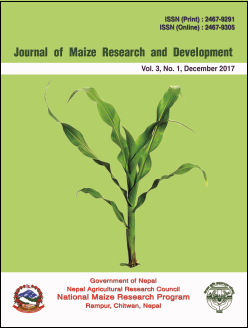Comparative study of impact of Azotobacter and Trichoderma with other fertilizers on maize growth
DOI:
https://doi.org/10.3126/jmrd.v3i1.18915Keywords:
Azotobacter, Trichoderma, Maize, Farmyard manure, NPKAbstract
Biofertilizers may be a better eco-friendly option to maintain soil fertility. The study was conducted to investigate the effect of Azotobacter and Trichoderma on the vegetative growth of maize (Zea mays L.) plants. The experiment was carried out in medium sized pots, at IAAS, Lamjung (Feb 2017 - May 2017) in completely randomized design (CRD), consisting eight treatments and three replications. Treatments were namely T1 (control), T2 (Azotobacter), T3 (Trichoderma), T4 (Azotobacter + Trichoderma), T5 (NPK), T6 (Azotobacter + Trichoderma + FYM), T7 (Azotobacter + Trichoderma + FYM + NPK), T8 (FYM). Azotobacter showed a positive increase in plant height, stem girth, dry shoot weight, root length and width, and root weight while Trichoderma displayed either negative or minimal impact. Effect of FYM was lower than Azotobacter but considerably higher than Trichoderma. Trichoderma seriously inhibited the expression of Azotobacter when used together. Trichoderma even suppressed the outcome (except shoot weight) of FYM when used together. Root length was the longest in Azotobacter inoculation. The highest number of leaves was in T7 followed by Azotobacter (T2) and NPK (T5). Unlike leaf width, Azotobacter showed a negligible increase in leaves length while Trichoderma wherever present showed the negative impact. Minimum chlorophyll content was found in Azotobacter or Trichoderma after 73 days. Azotobacter treatment showed early tasseling than Trichoderma. The association of Azotobacter and Trichoderma increased the biomass. Azotobacter has significant effects on growth parameters of maize and can supplement chemical fertilizer, while Trichoderma was found to inhibit most of the growth parameters.




